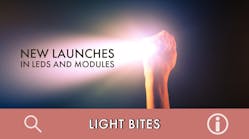German auto maker Audi has been the car industry’s biggest enthusiast for using OLEDs in taillights, advocating the technology both for design and safety advantages. Now, it is also articulating another reason: OLEDs could support a new revenue stream for the company.
In an online discussion with OLED supplier OLEDWorks, Audi’s head of lighting development Stephan Berlitz hinted that Audi might offer far more than the four dynamic design choices it currently offers, and that it could expand the technology beyond the three models that now incorporate it.
Today, drivers of the high-end S8 luxury sedan can bounce between the four geometric looks — Audi calls them “signatures” — by tapping controls in the vehicle’s multimedia interface (MMI) system. That will continue to be the case as Audi expands its stable of signatures. But Audi is also contemplating mobile phone-based controls, Berlitz said. The digital nature of OLED panels lends them to such control. (As a reminder, OLEDs — organic light emitting diodes — are thin patches of material that light up in response to an electric current and as such can offer design advantages; by comparison, an LED is a single point of light.)
As the design options multiply, Audi is contemplating providing access to all the signatures, for a fee.
“In the future, of course we want the customer to select — maybe function on-demand — to select the signature,” Berlitz told OLEDWorks CEO David DeJoy. Thinking about how it might work, Berlitz notes that the fee for signatures might be “one dollar once and maybe fifty dollars for the month, and 200 for the complete lifetime.”
Would there really be a market for such an automotive lighting offering?
Audi head of lighting innovation Michael Kruppa believes that, in the premium car market, the answer is decidedly yes.
“In the end, you want to make your car your car,” Kruppa said. “The same way you’re going to choose the lacquer, the same way you choose the color of your seats, you want to have something which is individual. You’re spending a lot of money for a premium car. So why not get the chance to change something which is fulfilling your wish?
“Or, if you have multiple users, like your family, your kids, your wife, your father, your mother, whatever — if they could change the car as soon as they’re entering the car, the user experience will be even better. You will create a trustful relationship between yourself and the car. And this is happening with light, because this is direct feedback,” Kruppa said.
Audi’s OLEDWorks OLED taillights not only provide a customized look, but they also flash warning signs that alert trailing motorists to conditions and hazards such as ice, traffic jams, and proximity. The company demonstrated that feature at the CES consumer electronics show in Las Vegas early this year.
Ingolstadt-based Audi currently offers four automotive lighting signatures as a standard feature on its S8 luxury sedan, a more powerful version of its A8 luxury sedan, for which it offers three signatures. (OLEDWorks announced four for the A8 in April; subsequent Audi marketing material clarifies that there are four on the S8 version of the A8, and three on the A8 itself).
Audi began making OLED signatures a standard feature, rather than an option, last November.
It first ventured into OLED lighting signatures in 2020 with its Q5 luxury SUV.
You can access the blog with an embedded video from the OLEDWorks website.
MARK HALPER is a contributing editor for LEDs Magazine, and an energy, technology, and business journalist ([email protected]).
*Updated July 22, 2022 for external link to blog.
For up-to-the-minute LED and SSL updates, follow us on Twitter. You’ll find curated content and commentary, as well as information on industry events, webcasts, and surveys on our LinkedIn page and our Facebook page.

Mark Halper | Contributing Editor, LEDs Magazine, and Business/Energy/Technology Journalist
Mark Halper is a freelance business, technology, and science journalist who covers everything from media moguls to subatomic particles. Halper has written from locations around the world for TIME Magazine, Fortune, Forbes, the New York Times, the Financial Times, the Guardian, CBS, Wired, and many others. A US citizen living in Britain, he cut his journalism teeth cutting and pasting copy for an English-language daily newspaper in Mexico City. Halper has a BA in history from Cornell University.





